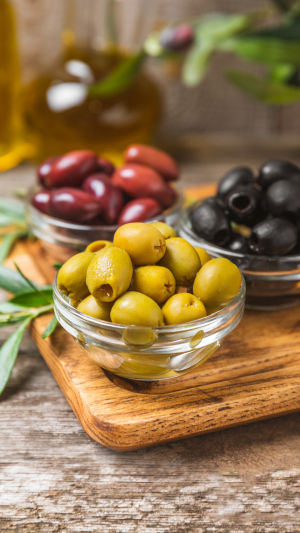Olives are one of the oldest cultivated crops, dating back thousands of years ago, and they remain a staple ingredient in Mediterranean cuisine and beyond.
These small, oval fruits are prized not only for their health benefits but also for their complex, bold flavour.
When people ask "What does an olive fruit taste like?", the answer can vary significantly depending on the type, ripeness, and how it's prepared. From briny, salty green olives to the rich, almost sweet black varieties, olives have a unique profile that can be described as an acquired taste. Let's dive into the characteristics that make the flavour of olives so distinctive.
<h3>The Raw Taste: Bitterness and Complexity</h3>
If you were to taste an olive right off the tree, you would likely be surprised at how unappetizing it is. Raw olives are extremely bitter due to a compound called oleuropein, which is responsible for their astringency. This bitterness can be overpowering and unpleasant, which is why olives are rarely consumed raw. To make them edible, they undergo a curing process that transforms their flavour from harsh and inedible to complex and enjoyable.
<h3>The Role of Curing in Flavor Development</h3>
Curing is the key to developing the signature taste of olives. Depending on the method—whether brined, dry-cured, or water-cured—the flavour of the olive will change. Brining is the most common method, and it involves soaking the olives in salt water for a while. This reduces the bitterness and introduces a salty, briny quality that many people associate with olives.
For example, green olives, which are picked before they fully ripen, tend to have a firmer texture and a sharper, more tangy flavour when brined. In contrast, black olives, harvested at peak ripeness, often have a richer, deeper flavour profile with sweet undertones. The curing method also affects the texture, with some methods resulting in a softer, more delicate bite, while others leave the olives slightly chewy or firm.
<h3>Green vs Black Olives: A Flavor Comparison</h3>
There are many types of olives, but they can generally be categorized into two main groups: green and black. The distinction isn't about different species, but rather about the ripeness of the fruit when harvested. This difference in maturity plays a crucial role in their taste.
- Green Olives: Green olives are harvested before they are fully ripe. As a result, they have a more robust, tangy, and slightly bitter flavour. Their texture is usually firmer, making them ideal for stuffing with pimentos, garlic, or almonds. The bitterness is more pronounced, but the curing process adds saltiness, making them a favourite in salads, tapenades, or served as snacks. The brininess of green olives can sometimes have a sharp, almost metallic note, which some people adore, while others might find it too strong.
- Black Olives: Black olives are allowed to ripen on the tree, giving them a milder, more balanced flavour. These olives are often less bitter and can have a slight sweetness that complements their salty, brined taste. Black olives are softer in texture, with a richer and more buttery mouthfeel. They are commonly used in pizzas, pasta dishes, or simply enjoyed as table olives. Some black olives, such as the Greek Kalamata variety, have a fruity flavour with a robust earthiness, making them popular in Mediterranean dishes.
<h3>Salty and Umami: The Essence of Olives</h3>
Beyond their inherent bitterness and sweetness, olives are celebrated for their salty and umami qualities. The saltiness is a direct result of the curing process, which draws out moisture and helps mellow out the olive's natural bitterness. This saltiness can vary depending on how long the olives have been cured and in what type of brine or solution. For some, this saltiness is the highlight of olives, while others may find it overpowering if not balanced with other flavours.
Umami is one of the core flavour sensations present in olives. This umami flavour is more pronounced in certain types, such as dry-cured olives, which concentrate on the fruit's natural flavours. Olives are often compared to cheese or mushrooms in their umami richness, which is why they pair so well with cheeses and bread.
<h3>A Versatile Ingredient in Cooking</h3>
Olives' unique flavour profile makes them a versatile ingredient in both savoury and sweet dishes. Their salty, umami-rich taste complements a variety of foods, from cheeses to vegetables and grains. In Mediterranean cuisine, olives are often paired with ingredients like feta cheese, tomatoes, garlic, and fresh herbs such as oregano and thyme. The combination of these flavours creates a complex, satisfying dish that highlights the olive's natural qualities.
Olive oils, pressed from the fruit, offer another dimension of taste. Known for its peppery and slightly fruity flavour, olive oil is an essential component in Mediterranean diets, enhancing dishes with a subtle depth that echoes the flavour of the whole fruit.
The taste of olives can be described as bold, salty, tangy, and even sweet, depending on the variety and how they're cured. For many, olives are an acquired taste due to their bitterness and strong flavours, but once you develop a palate for them, they can be incredibly satisfying.
Whether enjoyed as a simple snack or incorporated into complex dishes, olives offer a versatile and delicious flavour that reflects their Mediterranean roots. The next time you taste an olive, you'll be savouring centuries of culinary tradition packed into one tiny fruit.





